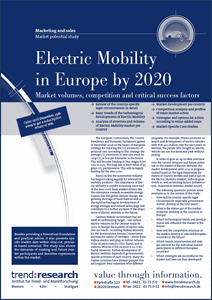Electric mobility in Europe by 2020 (Geplant)
Market volumes, competition and critical success factors
Broschüre:

The European Commission, the Council Presidency and European Parliament agreed in December 2008 on the basics of European Strategy for reducing the CO2 emissions of personal cars. According to this strategy the average CO2 emissions of new cars must be 120g CO2 or less per kilometre in the future. This will become binding in four stages from 2012 to 2015. The long aim is limit value of 95 gram CO2 per kilometre. This will be legally binding for the year 2020.
Based on this the automobile industry has begun looking eagerly for alternative mobility products – the importance of Electric Mobility is rapidly increasing since end of the year 2008. Basic market drivers like the orientation towards renewable energy sources due the global climate change, the growing shortage of fossil fuels as well as the rapid technological development of energy storages and vehicle technology will contribute to a further increase of the importance of Electric Mobility in the future.
German Federal Government has set itself an ambitioning target – one million electric vehicles on the German roads by 2020. In Europe the number of electric vehicles can reach – according Federal Ministry for the Environment, Nature Conservation and Reactor Safety of Germany – about three million electric and plug-in-hybrid vehicles if the oil price costs 60 USD/ barrel, and 16 millions vehicles if the oil price is 110 USD/ barrel. However, further development of Electric Mobility depends of governmental-specific activities of each country. Many European countries have already grasped this and support their industries whit different programs. For example, France promotes research and development of electric vehicles with EUR 400 million over the next years. In Norway, the people who bought an electric vehicle can use bus lanes and park without paying.
In order to give an up-to-date overview over the current situation and future potential on the market of Electric Mobility, the market development until 2020 is prognosticated based on the legal framework (by means of country profiles and status quo on the Electric Mobility market), technological trends as well as limiting factors (infrastructure, cooperation between market actors).
The following questions provide some examples as to the content of the study:
- How will he country-specific legal circumstances, especially government stimuli, develop in the next years?
- What is the status quo of the market of Electric Mobility in the countries in Europe?
- Which technological trends and developments will influence the market in the future?
- How will the competitive structure of the market develop in selected European countries in the future?
- Which trends, opportunities and risks are relevant for the individual market participants in different European countries?
- Which strategies are successful on the market and how are they developed?
Besides providing a theoretical foundation and practical advice, it also presents specific market date within clear-cut, premises-based scenarios. The study also shows the demands of existing and future market participants and describes experiences within the market.
On the basis of current developments and discussions, the study demonstrates and analyses the specific situation in European country in detail and shows the future development of Electric Mobility market up until 2020 in terms of different scenarios.
Alongside the quantitative analysis of the market, the market will be portrayed via a qualitative depiction of e.g. competition intensity, opportunities and risks etc.
Based on these data and forecasts, the study enables its readers to assess the plausibility of their own strategies and market data. Furthermore, the analysis of trends, opportunities and risks within the market contributes towards optimal market positioning in decisions pertaining to strategy and investment.
trend:research implements a variety of field and desk research methods. Alongside extensive intranet and internet database analysis (including journals, publications, conferences, company reports, etc.), the market potential study comprises ca. 300 structured interviews with the following target groups in each country:
- Energy suppliers and grid operators
- Automobile industry
- Battery manufacturers
- Advisors, associations and other experts
The analysis of field and desk research data leads to reliable conclusions regarding markets, trends, competition and dealing with the options within the Electric Mobility market. By means of the multivariate Trend-Impact-AnalysisTM, data and information are quantified and structured into a knowledge database. This is then used to build scenarios and deduce accurate market predictions.
The market potential study is aimed at all stake holders within the international market of Electric Mobility, thus providing a fundamental view of all data, discussions and market movements relevant to this market.
By means of detailed analysis of Electric Mobility, the study offers an overview for energy providers, automobile industry and battery manufacturers.
The study is aimed at management, CEO, head of marketing and distribution, business development etc.
